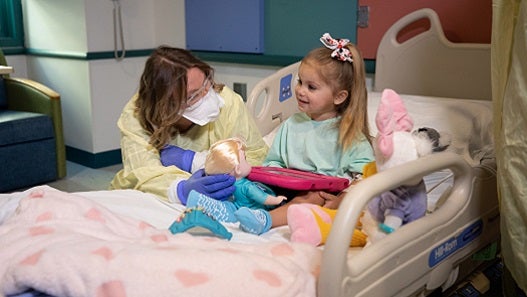A Prescription for Play: The Role of Play in Helping Children Heal
November 10, 2021
 When you think about healing from an illness or injury, what comes to mind? You might conjure up images of spoonfuls of medicine or hot chicken noodle soup. You might imagine getting plenty of bedrest and “get well” cards. In times of injury or chronic illness, you might consider the need for physical therapy or other supports.
When you think about healing from an illness or injury, what comes to mind? You might conjure up images of spoonfuls of medicine or hot chicken noodle soup. You might imagine getting plenty of bedrest and “get well” cards. In times of injury or chronic illness, you might consider the need for physical therapy or other supports.
For patients at Valley Children’s, that commonly conjured-up list is missing one essential item: play.
Why is Play Essential for a Child’s Healing?
As is often said at Valley Children’s: play is the work of children. Play is an essential part of childhood, and through play, children begin to learn and understand the world around them. Play not only allows them to use their creativity as they develop, it’s important for healthy brain development. Through play, children can imagine their own world, build confidence, conquer fears and solve problems.
When children are hospitalized or experience an acute or chronic injury or illness, they may feel a deep sense of loss and isolation caused by an abrupt break from their normal routine and environment. And because children process the world differently than adults, they may not be able to describe how they feel in a way that adults understand. Play is a crucial outlet, a way children can process their emotions, express how they are feeling and assert a sense of control over what might otherwise feel like a very uncertain situation.
Toys as Tools: Using Play to Help Heal
Valley Children’s Child Life team is dedicated to the role of play in helping a child cope with the fear, confusion, loss of control and isolation that can accompany a hospital stay or chronic illness.
“Child Life Specialists are here to support the emotional safety of our patients and lessen the trauma of being hospitalized,” says Rose Luna, a Child Life Specialist in the pediatric intensive care unit (PICU) at Valley Children’s Hospital.
Put simply, Child Life Specialists focus on the coping needs of patients and their families. They support hospitalized children and their families with age- and ability-appropriate activities that can help educate and connect, with the goal of reducing fear, anxiety and pain. A Child Life Specialist might point out on a doll what the child’s new G-tube looks like and how it works. Another might stop in for a game of Uno with a teen patient to chat and provide social interaction for the patient and their family.
“Child Life Specialists use play to help patients understand the hospital environment and their medical experiences,” says Luna. “Toys are tools, along with tangible medical equipment to meet patients at their developmental stage and support them through their treatment at the hospital.”
Even during the COVID-19 pandemic, Valley Children’s has prioritized play as an essential function. By modifying environments and processes to follow CDC guidelines, the Child Life team is able to continue providing this important part of children’s healing.
And it doesn’t stop there – Valley Children’s is remodeling the Playroom and playground to ensure kids continue “the business of being kids” by playing, learning and healing well into the future.
Learn More About Child Life
Join us in celebrating 51 years of Child Life services at Valley Children’s Hospital by learning more about the Child Life profession and how it helps kids and families. Learn more from the Association of Child Life Professionals by visiting their website: www.childlife.org.